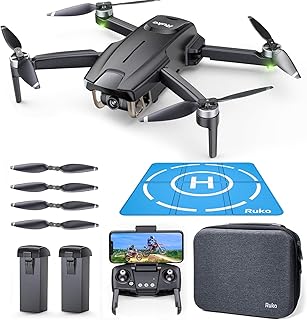How to Fly a Ruko Drone: A Beginner's Guide
Ruko drones offer a fun and accessible way to experience the world from a new perspective. This beginner's guide will help you get started with your Ruko drone safely and confidently.
1. Unboxing and Familiarization:
* Charge the Battery: Before anything else, charge the drone's battery fully. This is crucial for optimal flight performance.
* Familiarize Yourself: Read through the user manual that comes with the drone. It provides essential information on controls, features, safety tips, and troubleshooting.
* Check the Components: Make sure you have all the necessary components, including the drone, remote control, charging cable, extra batteries (if applicable), and propellers.
2. Download and Install the App:
* Download the App: Most Ruko drones use a dedicated app for controlling the drone and accessing features like camera settings, flight modes, and real-time video feed. Download the app from the App Store or Google Play Store.
* Connect to the Drone: Follow the app instructions to connect your smartphone or tablet to the drone. This usually involves pairing the device with the remote control.
3. Pre-Flight Check:
* Propeller Inspection: Inspect the propellers for damage or loose screws. Replace any damaged propellers before flight.
* Battery Level: Ensure the battery is fully charged before takeoff.
* Open Space: Choose a spacious open area with no obstacles or obstructions, like trees or power lines.
* Wind Conditions: Avoid flying in windy conditions, especially for beginners. Strong winds can make it difficult to control the drone.
* Legal Regulations: Familiarize yourself with local drone regulations and ensure you are flying within legal limits.
4. First Flight and Controls:
* Takeoff: Gently lift the drone slightly off the ground and then press the takeoff button on the remote control.
* Controls: The remote control typically has two joysticks:
* Left Joystick: Controls the drone's yaw (rotation) and pitch (forward/backward movement).
* Right Joystick: Controls the drone's roll (left/right movement) and throttle (up/down movement).
* Practice Hovering: Before venturing further, practice hovering the drone in a safe, open area.
* Landing: Once you're ready to land, gently lower the drone to the ground.
* Calibration: Calibrate your drone's compass and sensors as recommended in the user manual. This ensures accurate navigation and flight stability.
5. Additional Tips for Beginners:
* Start Slowly: Don't rush into advanced maneuvers like flips or tricks. Start with basic hovering and straight-line flight.
* Take Breaks: If you're feeling overwhelmed, take a break and come back to flying later.
* Practice Makes Perfect: Flying a drone takes practice and patience. Don't get discouraged if it takes time to get comfortable.
* Safety First: Always prioritize safety. Be aware of your surroundings and potential hazards.
6. Advanced Features (After Mastering Basics):
* Flight Modes: Many Ruko drones offer various flight modes, such as beginner mode, GPS mode, and headless mode. Experiment with these modes to enhance your flying experience.
* Camera Settings: Adjust camera settings like resolution, video quality, and picture settings to capture stunning aerial footage.
7. Troubleshooting:
* Drone Not Connecting: Ensure the drone and remote control are turned on, the battery is charged, and you're connected to the correct Wi-Fi network.
* Low Battery: Land the drone immediately if you receive a low battery warning.
* Lost Signal: Stay within the drone's range (typically around 300-500 meters) to maintain a stable connection.
* Drifting: Check for wind conditions and ensure the drone is calibrated correctly.
By following these steps and practicing regularly, you can master the basics of flying your Ruko drone and enjoy the exciting world of aerial photography and videography. Always prioritize safety and have fun exploring the skies!


